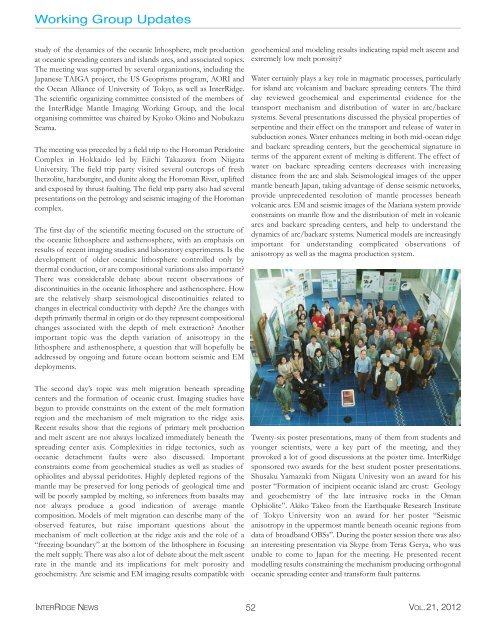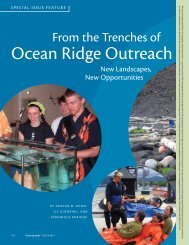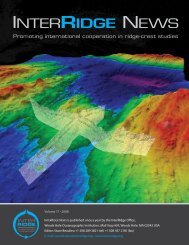Full version, low resolution, 7.5MB - InterRidge
Full version, low resolution, 7.5MB - InterRidge
Full version, low resolution, 7.5MB - InterRidge
Create successful ePaper yourself
Turn your PDF publications into a flip-book with our unique Google optimized e-Paper software.
Working Group Updates<br />
study of the dynamics of the oceanic lithosphere, melt production<br />
at oceanic spreading centers and islands arcs, and associated topics.<br />
The meeting was supported by several organizations, including the<br />
Japanese TAIGA project, the US Geoprisms program, AORI and<br />
the Ocean Alliance of University of Tokyo, as well as <strong>InterRidge</strong>.<br />
The scientific organizing committee consisted of the members of<br />
the <strong>InterRidge</strong> Mantle Imaging Working Group, and the local<br />
organising committee was chaired by Kyoko Okino and Nobukazu<br />
Seama.<br />
The meeting was preceded by a field trip to the Horoman Peridotite<br />
Complex in Hokkaido led by Eiichi Takazawa from Niigata<br />
University. The field trip party visited several outcrops of fresh<br />
lherzolite, harzburgite, and dunite along the Horoman River, uplifted<br />
and exposed by thrust faulting. The field trip party also had several<br />
presentations on the petrology and seismic imaging of the Horoman<br />
complex.<br />
The first day of the scientific meeting focused on the structure of<br />
the oceanic lithosphere and asthenosphere, with an emphasis on<br />
results of recent imaging studies and laboratory experiments. Is the<br />
development of older oceanic lithosphere controlled only by<br />
thermal conduction, or are compositional variations also important?<br />
There was considerable debate about recent observations of<br />
discontinuities in the oceanic lithosphere and asthenosphere. How<br />
are the relatively sharp seismological discontinuities related to<br />
changes in electrical conductivity with depth? Are the changes with<br />
depth primarily thermal in origin or do they represent compositional<br />
changes associated with the depth of melt extraction? Another<br />
important topic was the depth variation of anisotropy in the<br />
lithosphere and asthenosphere, a question that will hopefully be<br />
addressed by ongoing and future ocean bottom seismic and EM<br />
deployments.<br />
The second day’s topic was melt migration beneath spreading<br />
centers and the formation of oceanic crust. Imaging studies have<br />
begun to provide constraints on the extent of the melt formation<br />
region and the mechanism of melt migration to the ridge axis.<br />
Recent results show that the regions of primary melt production<br />
and melt ascent are not always localized immediately beneath the<br />
spreading center axis. Complexities in ridge tectonics, such as<br />
oceanic detachment faults were also discussed. Important<br />
constraints come from geochemical studies as well as studies of<br />
ophiolites and abyssal peridotites. Highly depleted regions of the<br />
mantle may be preserved for long periods of geological time and<br />
will be poorly sampled by melting, so inferences from basalts may<br />
not always produce a good indication of average mantle<br />
composition. Models of melt migration can describe many of the<br />
observed features, but raise important questions about the<br />
mechanism of melt collection at the ridge axis and the role of a<br />
“freezing boundary” at the bottom of the lithosphere in focusing<br />
the melt supply. There was also a lot of debate about the melt ascent<br />
rate in the mantle and its implications for melt porosity and<br />
geochemistry. Are seismic and EM imaging results compatible with<br />
geochemical and modeling results indicating rapid melt ascent and<br />
extremely <strong>low</strong> melt porosity?<br />
Water certainly plays a key role in magmatic processes, particularly<br />
for island arc volcanism and backarc spreading centers. The third<br />
day reviewed geochemical and experimental evidence for the<br />
transport mechanism and distribution of water in arc/backarc<br />
systems. Several presentations discussed the physical properties of<br />
serpentine and their effect on the transport and release of water in<br />
subduction zones. Water enhances melting in both mid-ocean ridge<br />
and backarc spreading centers, but the geochemical signature in<br />
terms of the apparent extent of melting is different. The effect of<br />
water on backarc spreading centers decreases with increasing<br />
distance from the arc and slab. Seismological images of the upper<br />
mantle beneath Japan, taking advantage of dense seismic networks,<br />
provide unprecedented <strong>resolution</strong> of mantle processes beneath<br />
volcanic arcs. EM and seismic images of the Mariana system provide<br />
constraints on mantle f<strong>low</strong> and the distribution of melt in volcanic<br />
arcs and backarc spreading centers, and help to understand the<br />
dynamics of arc/backarc systems. Numerical models are increasingly<br />
important for understanding complicated observations of<br />
anisotropy as well as the magma production system.<br />
Twenty-six poster presentations, many of them from students and<br />
younger scientists, were a key part of the meeting, and they<br />
provoked a lot of good discussions at the poster time. <strong>InterRidge</strong><br />
sponsored two awards for the best student poster presentations.<br />
Shusaku Yamazaki from Niigata Univesity won an award for his<br />
poster “Formation of incipient oceanic island arc crust: Geology<br />
and geochemistry of the late intrusive rocks in the Oman<br />
Ophiolite”. Akiko Takeo from the Earthquake Research Institute<br />
of Tokyo University won an award for her poster “Seismic<br />
anisotropy in the uppermost mantle beneath oceanic regions from<br />
data of broadband OBSs”. During the poster session there was also<br />
an interesting presentation via Skype from Teras Gerya, who was<br />
unable to come to Japan for the meeting. He presented recent<br />
modelling results constraining the mechanism producing orthogonal<br />
oceanic spreading center and transform fault patterns.<br />
INTERRIDGE NEWS 52 VOL.21, 2012
















